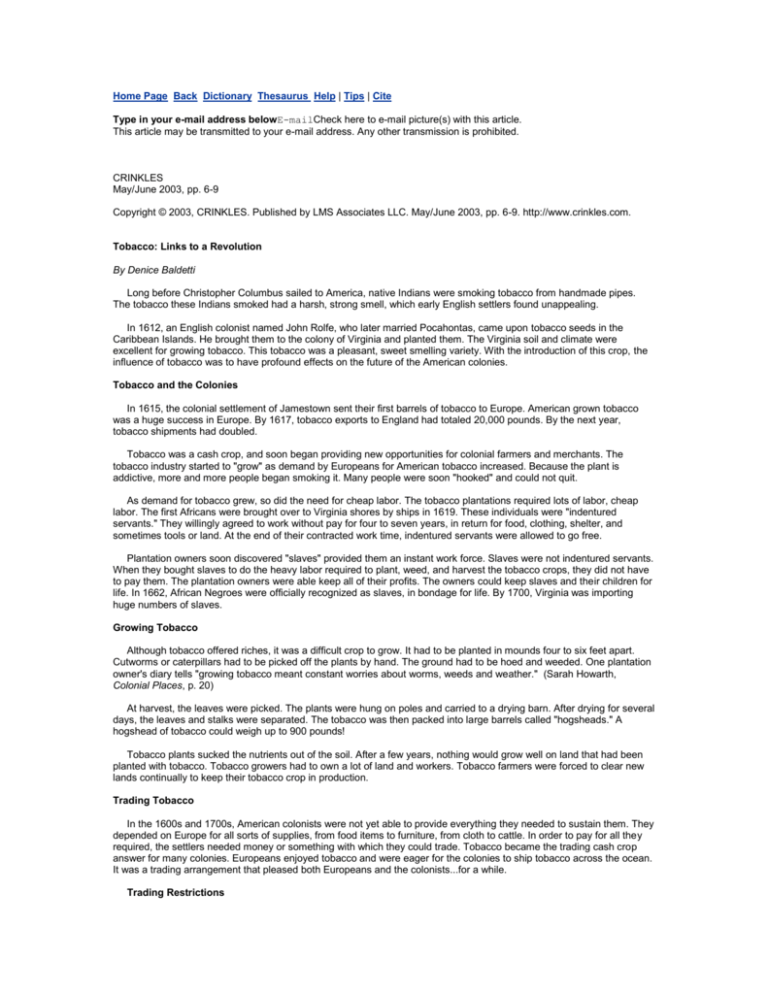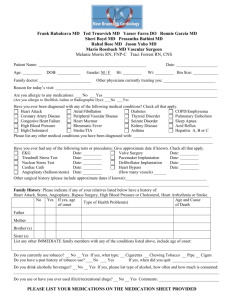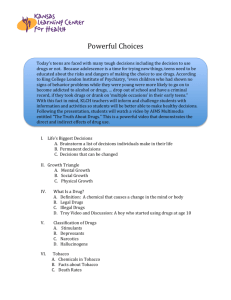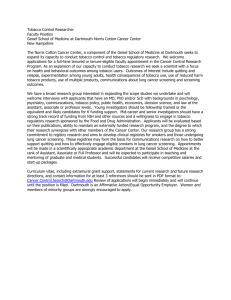
Home Page Back Dictionary Thesaurus Help | Tips | Cite
Type in your e-mail address belowE-mailCheck here to e-mail picture(s) with this article.
This article may be transmitted to your e-mail address. Any other transmission is prohibited.
CRINKLES
May/June 2003, pp. 6-9
Copyright © 2003, CRINKLES. Published by LMS Associates LLC. May/June 2003, pp. 6-9. http://www.crinkles.com.
Tobacco: Links to a Revolution
By Denice Baldetti
Long before Christopher Columbus sailed to America, native Indians were smoking tobacco from handmade pipes.
The tobacco these Indians smoked had a harsh, strong smell, which early English settlers found unappealing.
In 1612, an English colonist named John Rolfe, who later married Pocahontas, came upon tobacco seeds in the
Caribbean Islands. He brought them to the colony of Virginia and planted them. The Virginia soil and climate were
excellent for growing tobacco. This tobacco was a pleasant, sweet smelling variety. With the introduction of this crop, the
influence of tobacco was to have profound effects on the future of the American colonies.
Tobacco and the Colonies
In 1615, the colonial settlement of Jamestown sent their first barrels of tobacco to Europe. American grown tobacco
was a huge success in Europe. By 1617, tobacco exports to England had totaled 20,000 pounds. By the next year,
tobacco shipments had doubled.
Tobacco was a cash crop, and soon began providing new opportunities for colonial farmers and merchants. The
tobacco industry started to "grow" as demand by Europeans for American tobacco increased. Because the plant is
addictive, more and more people began smoking it. Many people were soon "hooked" and could not quit.
As demand for tobacco grew, so did the need for cheap labor. The tobacco plantations required lots of labor, cheap
labor. The first Africans were brought over to Virginia shores by ships in 1619. These individuals were "indentured
servants." They willingly agreed to work without pay for four to seven years, in return for food, clothing, shelter, and
sometimes tools or land. At the end of their contracted work time, indentured servants were allowed to go free.
Plantation owners soon discovered "slaves" provided them an instant work force. Slaves were not indentured servants.
When they bought slaves to do the heavy labor required to plant, weed, and harvest the tobacco crops, they did not have
to pay them. The plantation owners were able keep all of their profits. The owners could keep slaves and their children for
life. In 1662, African Negroes were officially recognized as slaves, in bondage for life. By 1700, Virginia was importing
huge numbers of slaves.
Growing Tobacco
Although tobacco offered riches, it was a difficult crop to grow. It had to be planted in mounds four to six feet apart.
Cutworms or caterpillars had to be picked off the plants by hand. The ground had to be hoed and weeded. One plantation
owner's diary tells "growing tobacco meant constant worries about worms, weeds and weather." (Sarah Howarth,
Colonial Places, p. 20)
At harvest, the leaves were picked. The plants were hung on poles and carried to a drying barn. After drying for several
days, the leaves and stalks were separated. The tobacco was then packed into large barrels called "hogsheads." A
hogshead of tobacco could weigh up to 900 pounds!
Tobacco plants sucked the nutrients out of the soil. After a few years, nothing would grow well on land that had been
planted with tobacco. Tobacco growers had to own a lot of land and workers. Tobacco farmers were forced to clear new
lands continually to keep their tobacco crop in production.
Trading Tobacco
In the 1600s and 1700s, American colonists were not yet able to provide everything they needed to sustain them. They
depended on Europe for all sorts of supplies, from food items to furniture, from cloth to cattle. In order to pay for all they
required, the settlers needed money or something with which they could trade. Tobacco became the trading cash crop
answer for many colonies. Europeans enjoyed tobacco and were eager for the colonies to ship tobacco across the ocean.
It was a trading arrangement that pleased both Europeans and the colonists...for a while.
Trading Restrictions
In North America, in 1754, war broke out between Great Britain and France over acquiring land. In Europe, this war
was called the Seven Years' War. American colonists called this battle the French and Indian War. The long war had cost
Great Britain a lot of money. To recover some of their losses, Britain announced that American colonists would need to
pay new taxes. This greatly angered the colonists. The beginnings of discord between Britain and the colonies were
quickly to grow stronger.
One trade law Britain had earlier imposed concerned trade with foreign countries. A law, called the Navigation Act, was
passed in 1660. This law set forth a list of items that the colonies could only sell to Great Britain. The list included tobacco.
The Navigation Act ensured that a high percentage of the profit from colonial tobacco would stay in England. Tobacco
growers, large and small, were finding themselves forever in debt to British export agents. They owed millions of pounds
of tobacco to these agents.
The Tobacco War
In 1772, the bottom dropped out of the tobacco market. Bankruptcy swept through the countryside. In Virginia, a
southern slave state, many planters believed they had little choice but to join in the growing colonial movement toward
independence. The Chesapeake Bay Region, the eastern coast of America from Maryland to Virginia, became known as
"Tobacco Coast." The growers in this region were beginning to believe that only American independence would free them
from the greatly corrupt tobacco wholesalers.
When war erupted, the people in the Chesapeake Bay region called the Revolutionary War, the "Tobacco War." Unfair
tobacco taxes imposed by Britain were causing many plantation owners to lose their mansions, slaves, and belongings. It
was time to take a stand.
"The Shot Heard 'Round the World"
April 18, 1775, Paul Revere rode out of Boston and through the nearby town of Lexington warning colonists along the
way that British soldiers were on the move. British redcoat troops reached Lexington at dawn on April 19, 1775. The
colonial minutemen were waiting. At the village green, the British troops found a line of minutemen armed and ready to
fire.
"Ye villains, ye rebels, disperse! Lay down your arms!" shouted Major John Pitcairn, a British officer. A shot suddenly
rang out. No one knows which side fired this first shot. (Penner, The Liberty Tree: The Beginning of the American
Revolution). This historic moment became known as the "shot heard 'round the world." The shot marked the beginning of
the American Revolutionary War. It was to become a battle for colonial independence that would last for eight long years.
"Tobacco Aristocracy"
The lives of people in the colony of Virginia revolved nearly completely around tobacco. About ten percent of these
people were very wealthy owners of huge tobacco plantations. Known as the "Tobacco Aristocracy," these wealthy men
seemed obsessed with becoming rich, building huge mansions, and owning large groups of slaves to work on their
tobacco plantations.
George Washington was a member of the "Tobacco Aristocracy." He maintained a very lavish lifestyle and owned
about 275 slaves. Thomas Jefferson also owned a great many slaves. Jefferson had inherited 52 slaves from his father
and 135 slaves from his wife's father. Both men wrote that slavery was evil, yet they were both slave owners. These men,
our founding fathers, and others in the "Tobacco Aristocracy" were caught in a bad situation. They were wealthy
plantation owners, and needed their slaves to work the tobacco fields. Yet, what would happen if they freed their slaves?
Would the plantation owners become poor? It was a very difficult situation.
The Tobacco Plant
What Does Tobacco Look Like?
Tobacco is related to the tomato and the potato plants. A tobacco plant grows between 4 to 6 feet high and produces
about 20 leaves. Each leaf is about 24 to 30 inches long, and about 15 to 18 inches wide. The plant grows a light pink
flower on top. The large leaves are light to dark green in color. Interestingly, one mature tobacco plant can produce a
million seeds a year. This is enough seed to plant about 100 acres of tobacco! Today farmers in the United States harvest
about 820,000 tons of tobacco. Find out more information about the tobacco plant and its history in encyclopedias.
Make Your Own Tobacco Plantation
Can you recreate this tobacco plantation?
(See picture, "Tobacco Plantation Activity.") Color and cut out the missing pieces. On a separate sheet of paper, paste or
glue stick to put them in the correct place. Finish the picture of the tobacco plantation.
Resources
Books
Kalman, Bobbie. Life on a Plantation. Crabtree, 1996. 32 p.
Stone, Lynne. Plantations. Rourke, 1993. 32 p.
Movies
Virginia Plantations. Atlas Video, 1986. 30 min.
Virginia's Great Plantation Houses. Finley-Holiday, 1994. 30 min.
Virginia Plantations (Website Examples)
Berkeley Plantation
http://www.berkeleyplantation.com
Carter's Grove
http//www.wise.virginia.edu/history/roots/mike/carter/main.html
Gunston Hall
http://www.gunstonhal.org/
James River Plantations
http.//www.jamesriverplantations.org/ Westover.html
Mt. Vernon
http://www.nountvernon.org/
Plantations
http://www.colonialconnections.com/plantations.htm
Sherwood Forest Plantation
http://www.sherwoodforest.org/
Shirley Plantation
http://www.shirleyplantation.com/
The effects of tobacco trade in the American colonies played a key role during the Revolutionary War. Explore more
about the effects of this cash crop upon the colonies in these nonfiction books about the American Revolution. The table
of contents and index were used to find the specific pages.
Carter, Alden R. Colonies in Revolt. Franklin Watts, 1988. pp. 26-27, 31, 67.
Hakim, Joy. Making Thirteen Colonies. Oxford University Press, 1993. pp. 40-41, 113-115, 117, 133, 142.
Howarth, Sarah. Colonial Places. Millbrook Press, 1994. pp. 19-21.
Kallen, Stuart A. Life During the American Revolution. (The Way People Live). Lucent Books, 2002. pp. 24-28.
Kallen, Stuart. Life in the Thirteen Colonies 1650-1750. Abdo & Daughters, 1990. pp. 33-37, 39, 45.
Masoff, Joy. American Revolution. Scholastic, Inc., 2000.
Masoff, Joy. Colonial Times. Scholastic, Inc., 2000. pp. 28, 34.
Sakurai, Gail. The Thirteen Colonies. Children's Press, 2000. pp. 8-9.
Tunis, Edwin. Colonial Living. Thomas Y. Crowell Company, 1957. pp. 76-81.
Here are current titles to browse for an overview of the American Revolution.
Kent, Deborah. The American Revolution: "Give Me Liberty, or Give Me Death!" Enslow Publishers, Inc., 1994. 128 p.
Maynard, Christopher. Revolution. Gareth Stevens Publishing, 2001. 32 p.
Penner, Lucille. The Liberty Tree: The Beginning of the American Revolution. Illustrated by David Wenzel. Random
House, 1998. 39 p.
Stefoff, Rebecca. Revolutionary War. Benchmark Books, 2001. 48 p.
Books About the Tobacco Industry
Connolly, Sean. Tobacco. Heinemann Library, 2001. 56 p.
Hirschfelder, Arlene B. Kick Butts! A Kid's Action Guide to a Tobacco-Free America. Julian Messner, 1998. 160 p.
MacDonald, Joan Vos. Tobacco and Nicotine Drug Dangers. Enslow Publishers, 2000. 64 p.
Pietrusza, David. Smoking. Lucent Books, 1997. 112 p.
Pringle, Lawrence P. Smoking: A Risky Business. Morrow Junior Books, 1996. 124 p.
Websites to Explore
Farm Life and Tobacco
http://www.lib.ncsu.edu/archives/exhibits/tobacco/farm.html
John Rolfe
http://www.apva.org/history/jrolfe.htm
The Mariner's Museum--Chesapeake Bay: Economy in the Colonial Period
http://www.mariner.org/chesapeakebay/economy/cbe001.html
Tobacco Timeline
http://www.tobacco.org/History/Tobacco_History.html
Tobacco in Business and Industry
http://www.lib.ncsu.edu/archives/exhibits/tobacco/tecon.html
Home Page | Current Events | Spotlight of the Month | World Almanac | Encyclopedia
Dictionary | Thesaurus | Help | Tips | Cite | Workbooks | Tutorial | Research Topics
Librarian's Corner | Privacy | Accessibility | License | Contact
Copyright © 2004 ProQuest Information and Learning Company. All rights reserved.







